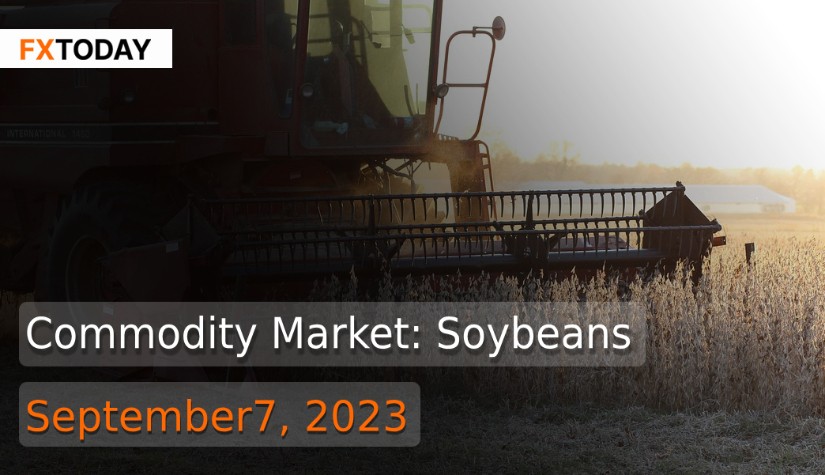Soybean Prices Surge Amidst Crop Quality Concerns and Supply Dynamics
Soybean prices experienced a notable increase due to ongoing concerns about the size and quality of this year's U.S. soybean crop. The latest crop progress and condition report released on Monday revealed a decline in the good-to-excellent rating, dropping to a mere 53%, marking the lowest level since 2012. Analysts are now anticipating that the final soybean yield may fall below 50 bushels per acre, raising concerns about ending stocks.
The latter half of August saw unusually dry conditions in the U.S. Corn Belt, which likely impacted soybean yields due to their reliance on late-season moisture. In response to this situation, speculators increased their bullish positions in Chicago soybean futures.
Chicago Board of Trade (CBOT) soybean futures surged during the week ending August 29, reaching a one-month high. This strength in soybeans is evident in funds' positioning, with money managers adding nearly 33,000 soy contracts to their net long position, which reached 90,985 futures and options contracts by August 29, marking their most significant net buying week since mid-June.
Additionally, money managers increased their net long position in CBOT soybean oil to an eight-month high of 58,317 futures and options contracts by August 29, up from 55,077 the previous week. Most-active soyoil futures have maintained prices above 60 cents per pound since mid-August, marking their longest streak of such prices since January.
The USDA reported daily U.S. soybean export sales for six consecutive days, but concerns persist as Brazil authorized early soybean planting in Mato Grosso, their largest producing state, deviating from the usual September 15 start date. Additionally, the USDA's quarterly report projected a decrease in U.S. agricultural exports for fiscal year 2024 compared to the revised FY 2023 forecast. This decline is primarily driven by lower exports of soybeans and soybean meal, with soybean exports expected to suffer due to reduced U.S. production, strong competition from South America, and robust domestic crush demand.
The dry weather's detrimental effects on crops were further confirmed by a U.S. government report, which exceeded most analysts' expectations in terms of the damage incurred. This report, released on Wednesday, led to an increase in Chicago soybean prices, raising concerns about supply.
In addition to crop conditions, the USDA data indicated that exporters had sold 251,000 metric tons of U.S. soybeans to unknown destinations, showcasing strong demand. This news, coupled with reduced crop ratings, fueled expectations that the USDA might lower its yield forecast in the upcoming monthly report scheduled for September 12. The USDA is already forecasting a significant decrease in domestic soy ending stocks for the 2023-24 marketing year.
Outside of the United States, China's weather bureau warned of heavy rain that could delay grain ripening and harvesting in Heilongjiang province, the country's top producer of soybeans. On a more positive note, Argentina is attempting to boost soybean exports by allowing shippers to use foreign currency income to purchase beans.
As a result of these factors, soybean prices in this timeframe might display a tendency to fluctuate within a certain range and experience some degree of upward movement. This is influenced by the ongoing unfavorable weather conditions, the sustained demand, including the resurgence in oil prices. However, the market could face competitive challenges from Brazil if domestic production remains robust and can offset the reduced supply during this period.
Data for Technical Analysis (1H) CFD US Soybeans Futures - Nov 23 (ZSX3)
Resistance : 1375.05, 1375.94, 1377.37
Support : 1372.19, 1371.30, 1369.87
1H Outlook
Source: Investing.com
Buy/Long 1 If the support at the price range 1370.19 - 1372.19 is touched, but the support at 1372.19 cannot be broken, the TP may be set around 1375.74 and the SL around 1369.00, or up to the risk appetite.
Buy/Long 2 If the resistance can be broken at the price range of 1375.05 - 1377.05, TP may be set around 1379.00 and SL around 1371.00, or up to the risk appetite.
Sell/Short 1 If the resistance at the price range 1375.05 - 1377.05 is touched, but the resistance 1375.05 cannot be broken, the TP may be set around 1371.99 and the SL around 1378.50, or up to the risk appetite.
Sell/Short 2 If the support can be broken at the price range of 1370.19 - 1372.19, TP may be set around 1368.90 and SL around 1376.00, or up to the risk appetite.
Pivot Points Sep 07, 2023 02:52AM GMT
| Name | S3 | S2 | S1 | Pivot Points | R1 | R2 | R3 |
|---|---|---|---|---|---|---|---|
| Classic | 1368.24 | 1369.87 | 1371.99 | 1373.62 | 1375.74 | 1377.37 | 1379.49 |
| Fibonacci | 1369.87 | 1371.30 | 1372.19 | 1373.62 | 1375.05 | 1375.94 | 1377.37 |
| Camarilla | 1373.09 | 1373.43 | 1373.78 | 1373.62 | 1374.46 | 1374.81 | 1375.15 |
| Woodie's | 1368.50 | 1370.00 | 1372.25 | 1373.75 | 1376.00 | 1377.50 | 1379.75 |
| DeMark's | - | - | 1372.81 | 1374.03 | 1376.56 | - | - |
Sources: Farm Policy News, Hellenic Shipping News
Maximize your knowledge: Blog
















